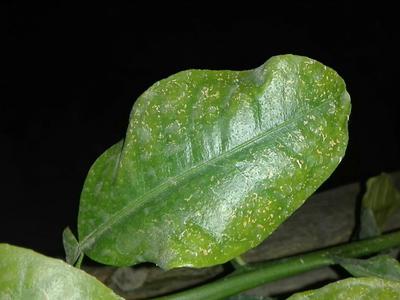Oriental Spider Mite
Eutetranychus orientalis
Mite
In a Nutshell
- The oriental spider mite is having similarities to the feeding damage of citrus red mite.
- Leaves become chlorotic and at high infestation lead to premature leaf fall, twig dieback, reduced quality of fruits and decreased vigor of the trees.
- A good water supply reduces the incidence and the damage caused by this pest.
Can also be found in
Symptoms
The damage is characterized by the appearance on the upper leaf side of feeding damage, mainly along the midrib, spreading to lateral veins. Pale-yellow streaks develop along midrib and leaf veins and eventually leaves become chlorotic. Sometimes the leaves seem to have a fine dust cover and little webbing can also be produced. Young infested leave margins are curling upwards. At high levels of infestation the mites feed and lay eggs over the whole upper leaf surface. This can cause premature defoliation, branch die-backs and fruit dropping. Next year's blossoming may be severely affected. If trees are under water stress even low pest population will lead to chlorosis on the fruits and premature leaf fall.
Recommendations

Organic Control
Eutetranychus orientalis has a large number of predators and other natural enemies, which is frequently sufficient to control its spread. Several Phytoseiidae and Stigmaeidae mites have been used in different countries for the effective control of the citrus oriental mite, e.g.: Euseius stipulatus, Typhlodromus phialatus, Neoseiulus californicus, Phytoseiulus persimilis. Predatory beetle like Stethorus spp and Orius thripoborus, but also lacewing larvae feed on the mites. You can either spray or dust your plants with sulphur to get rid of the pest.

Chemical Control
Always consider an integrated approach with preventive measures together with biological treatments if available. Treat the infested plants if more then 20% of their leaves and/or fruits are affected. Selective pesticides are highly recommended, as broad-spectrum insecticides may aggravate the situation. The use of several types of acaricides avoids the development of resistance.
What caused it?
Symptoms are caused by the feeding activity of the adults and nymphs of the citrus oriental mite, Eutetranychus orientalis. They are characterized by an oval-shaped, flat body, varying in colour from pale-brown, reddish brown to dark-green. They also have darker spots and lighter colored legs as long as the body. They infect mostly citrus trees and occasionally also other crops such as almonds, bananas, cassava and cotton. Usually found on the upper leaf surface they disperse mainly via wind. Depending on geographic occurence range of 8 - 27 generations per year, each female laying 30-40 eggs during their lifetime (2-3 weeks). Too low or to high humidity, high wind, drought or a poorly developed root system can worsen the situation. Optimal conditions for the oriental spider mite are 21-27°C and 59-70% humidity.
Preventive Measures
- Monitor the orchards weekly with a lens to assess numbers of mites.
- Avoid an excessive use of pesticides as this can influence negatively the populations of beneficial insects.
- Water the tree properly and avoid drought stress in hot weather.
- Avoid contact of branches with grasses or weeds on the ground.
- Keep the orchard clean of weeds.
- Remove waste and debris after harvest.



